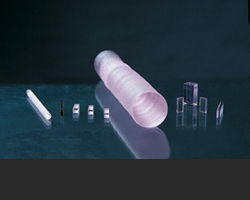
Nd:YLF
Nd:YLF is grown utilizing the modified Czochralsky technique. The use of high quality starting materials for crystal growth, whole boule interferometry, and precise measurement of bulk losses using transmission spectroscopy assures that each crystal will perform to customer specifications.
Advantages:
1. High power, low beam divergence, efficient single mode operation
2. High average power Q-switching at a moderate repetition rate
3. Linear polarized resonators for Q-switching and frequency doubling
4. Potential uniform mode for large diameter rods or slabs
5. Stimulated emission cross section is favorable for low CW threshold
6. Thermal lensing lower than that of YAG
7. 1053nm output of Nd:YLF matches gain curves of Nd:Glass and performs well as an oscillator and pre-amplifier for this host
| Dopant Concentration | 0.4~1.5 atm % |
| Orientation | a-cut or c-cut within 2° |
| Flatness | < λ/10 @ 632.8nm |
| Parallism | ≤10 " |
| Perpendicularity | ≤5 ' |
| Surface Quality | 10/5 ( MIL-O-13830A) |
| Size | Diameter: 2~10mm, Length: 10~120mm Upon request of customer |
| Dimensional Tolerances | Diameter +0.0/-0.03mm, Length ±0.5mm Chamfer: < 0.1 mm @ 45° |
| AR-Coating Reflectivity | ≤ 0.2% (@1047/1053nm) |
| Chemical Formaulay | LiY1.0-xNdxF4 |
| Density, g/cm3 | 3.99 |
| Mohs hardness | 4~5 |
| Lattice constant, A | a = 5.26, c = 10.94 |
| Refractive index, at 1.053 μm | no= 1.448; ne= 1.47 |
| Thermal conductivity, W x cm-1 x °K-1 | 0.06 |
| Thermal expansion ( a ), 10-6 x °C-1 | 13 along a, 8 along c |
| Thermooptical factor (dn/dT), at 1.06 μm | π = 4.3 x 10-6 x °K-1, σ = 2.0 x 10-6x °K-1 |
| Generated wavelength, μm | π = 1.047, σ = 1.053 |
| Laser Wavelength | 1047nm, 1053nm |
| Fluorescence Lifetime | 485μs |
| Emission Cross Section | 1.8×10-19cm2(E ∥ C) @1047nm 1.2×10-19cm2(E ⊥ C) @1053nm |
